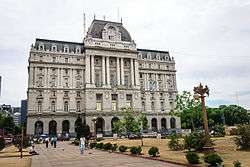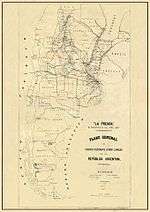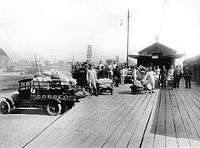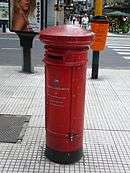Correo Argentino
| Correo Argentino | |
 | |
 The Buenos Aires Central Post Office building. | |
| S.A. overview | |
|---|---|
| Formed | 1748 [1] |
| Preceding S.A. |
|
| Jurisdiction | National |
| Headquarters | Buenos Aires |
| Motto | 10 años abrazando la Patria |
| Employees | 16,000 (2012)[2] |
| S.A. executive |
|
| Parent department | Ministerio de Planificación Federal de Argentina |
| Website | correoargentino.com.ar |
Correo Oficial de la República Argentina Sociedad Anónima, mostly known as "Correo Argentino" (since it was privatized in 1997) is the state-owned company that covers the postal service in Argentina.
History
The beginning: Viceroyalty


On 14 May 1514 the "Correo Mayor de Indias", headquartered in Lima, Peru was created. Under the mandatte of Carlos III of Spain the post service became part of the Viceroyalty of the Río de la Plata depending of the Kingdom of Spain. With the commercial activity increasing considerably, it was decided to create a post service at Buenos Aires. Domingo Basavilbaso made the arrangements to establish a post service in the region. It would be managed by a senior lieutenant designed by the head office at Lima.
On 1 July 1769, the service began its activities officially. Through the years it extended to the cities of Potosí and Santiago (Chile). Bruno Ramírez was the first postman of Argentine post, when the profession did not still exist in the country. Ramírez officially became post employee on 14 September 1771. Years later that would be promulgated as the Day of Postman in Argentina.[3]
Evolution
Post service in Argentina played a key role during the May Revolution because of orders and reports from the Primera Junta were distributed through letters. The first manager of the service was Melchor de Albín, designed in June 1810.
In 1826, during the presidency of Bernardino Rivadavia, the service was nationalised by a Law passed by the Congress of Provincias Unidas del Río de la Plata. Since then, the post service was named "Dirección General de Correos, Postas y Caminos", being Juan Manuel de Luca in charge. De Luca remained during 32 years,[4] being succeeded by Gervasio Antonio de Posadas. It was Posadas who placed the first post boxes in the city of Buenos Aires, apart of writing the rules for postmen and establishing lower prices for post rates.
Eduardo Olivera was chosen as director in 1874 replacing Posadas. Olivera wrote the new rules and sent a project for the Law of renew of post services, n° 816. During successive administrations, money orders, courier services, registered letters and declared values were implemented. After being an agency depending of Ministries of Finances and Interior, on June 1944 the Government of Argentina established the post service autonomy, naming it "Dirección General de Correos y Telecomunicaciones" (National Direction of Post and Telecommunication)
Palacio de Correos

Due to the increasing demand for post services in Argentina, in 1888 the Post Office director, Ramón Cárcano, proposed a specific building as seat for the postal service. French architect Norbert-Auguste Maillart designed the building, inspiring in the City Hall Post Office of New York City.
Works started in 1889, not being finished until 1928 when the building was officially inaugurated by president of Argentina Marcelo T. de Alvear.
ENCoTel
The "Empresa Nacional de Correos y Telégrafos" (ENCoTel) (in English: "Post and Telegraph National Company") was a state-owned company established in 1972 for post, telegraph and money services. During the National Reorganisation Process started in 1976, private companies were allowed to take part in post services, although the universal post services continued being managed by the state post.
Privatisation
In 1997, during the Carlos Menem's administration, ENCoTel was privatised. The service was granted in concession to "Correo Argentino", a company part of Sociedad Macri (SOCMA), owned by entrepreneur Franco Macri. In that way, Argentina became one of the first countries to privatise its post service. The contract of concession set a term of 30 years, also establishing that SOCMA would pay a six-monthly rent of A$ 51,6 million to the state. Nevertheless, the consortium built up a debt of near USD 900 million to private creditors and the state as well. In September 2001, SOCMA entered into a reorganization proceeding.[5][6][7]
The Palacio de Correos was declared National Heritage by Law 12,665 in 1997.[8] considering its architectural style and historic relevance. In 2002 the building ceased operations as seat of Correo Argentino.[9] Only a small part of the building continued its activities as a post office and sale of stamps, on Sarmiento street. The rest of the building became inactive.
See also
References
- ↑ "Historia del Correo Argentino", web oficial
- ↑ "Los supermercados lideran ranking de los empleadores", Ambito Financiero, 28 Ago 2012
- ↑ Efeméridas culturales en Argentina, Ministerio de Educación
- ↑ Juan Manuel de Luca, Biblioteca Nacional
- ↑ "Empresa Nacional de Correos y Telegrafos: Su privatización por concesión", Infoleg
- ↑ "De la patria contratista al control mismo del Estado", Infoleg, 31 Jan 2013
- ↑ "Correo Argentino: la primera empresa re estatizada", Primera Página Bonaerense, 31 May 2013
- ↑ Ley 12.665 - COMISION NACIONAL DE MUSEOS, MONUMENTOS Y LUGARES HISTORICOS
- ↑ "El Palacio de Correos dejó de recibir y de distribuir cartas", La Nación, 7 Sep 2002
External links
| Wikimedia Commons has media related to Post of Argentina. |